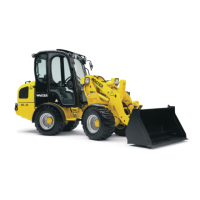
Do you have a question about the Wacker Neuson WL 30 and is the answer not in the manual?
| Brand | Wacker Neuson |
|---|---|
| Model | WL 30 |
| Category | Front End Loaders |
| Language | English |
Details about the manual's content, specifications, and the manufacturer's right to make changes.
Explains safety alert symbols, DANGER, WARNING, CAUTION, NOTICE, and NOTE.
Outlines manufacturer liability for unintended use and user responsibilities for safe operation.
Describes the loader's intended purpose and hazards of unintended or improper use.
Safety instructions for operators/users, including manual location and compliance with regulations.
Defines requirements for operating personnel and duties related to safety and work area monitoring.
General safety guidelines applicable during various operating phases and specific checks.
Addresses specific hazards and precautions for safe operation.
Instructions for safe towing, loading, and transporting the wheel loader.
Procedures for environmentally responsible disposal and dismantling of the loader.
Information on maintaining and replacing safety labels on the machine.
Details on various safety devices installed on the loader.
Overview of the loader's main components: frame, drive, axles, brakes, and steering.
Specifications for the engine, drive system, steering, electrical system, and performance data.
Information found on the loader's identification plates and component rating plates.
Provides detailed physical dimensions of the loader with specific tire sizes.
Identifies and describes the various controls and instruments within the operator's cab.
Explains the function of different indicator lights on the instrument panel.
Details the functions and operation of various switches and rocker switches.
Explains the purpose of key indicator devices like fuel gauge, tachometer, hour meter, and temp gauge.
Essential checks and procedures to perform before operating the loader.
Procedures for starting the loader's engine and checking systems.
How to operate the loader's drive system and manage speed.
General safety and operational procedures for performing work with the loader.
Details on optional equipment and their operation.
Safety warnings and preferred methods for towing the wheel loader.
Guidelines for safely loading and transporting the loader.
Steps to open load holding control valves to relieve hydraulic pressure.
Essential safety guidelines for personnel performing maintenance and inspection work.
Schedules for daily, weekly, and periodic servicing tasks.
Details on lubrication points and the types of grease and oil to use.
Procedures and safety precautions for cleaning the loader, including use of high-pressure water.
A checklist for a general safety inspection of the loader's components.
Table of fluids, capacities, and specifications for refilling.
General information on performing maintenance and inspection.
Possible causes and remedies for an engine that fails to start.
Troubleshooting steps when the engine runs but the loader does not move.
Identifies causes and solutions for engine overheating issues.
Possible causes and remedies for hydraulic system overheating.
Diagnoses issues leading to reduced machine performance.
A diagnostic flow chart for transmission pump and oil engine issues.
A diagnostic flow chart for common loader operational problems.
General safety rules and personnel qualifications for performing repair work.
Importance of using the articulated frame lock during repair work.
Warning against repairing accumulators due to high pressure and complexity.
Safety procedures for removing components, including pressure relief and cleanliness.
Prohibition of altering rated pressures or removing seals without consent.
Final checks and procedures after completing repair work.
Safety rule for performing engine repair work only when the loader is secured.
Safety requirements for performing welding, especially concerning ROPS/FOPS.
Safety measures for hydraulic system repairs, including pressure relief and hose replacement.
Safety regulations for brake repair work and fluid usage.
Safety procedures and checks required before final disposal of the loader.
Guidelines for recycling and disposing of loader parts and materials.
Information required for ordering replacement parts and using genuine parts.
Forms for recording inspection dates, operating hours, and garage signatures.